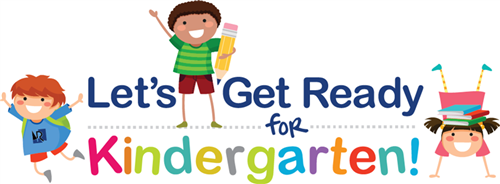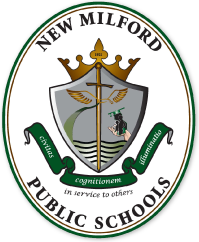-

Kindergarten Readiness
Listed below are some of our favorite resources to help children get ready for kindergarten.
Personal Data
Help your child learn their full name, age, home address, birthday, and telephone number. Children can practice these skills through everyday conversation and reinforcement. Whether it is a song you sing together, a coloring activity, or magnetic letter activities, repeated exposure helps children acquire this information.
Identifying Body Parts
- Song – “Head, Shoulders, Knees, and Toes”
- Play Simon Says - let them be “Simon” to practice naming the parts themselves
- Play Twister
Gross Motor Skills
- Play with a large ball. Encourage your child to kick the ball using one foot and then the other. Then throw and catch it too. You can let some of the air out of a beach ball to make it easier for children who are really struggling with learning to catch.
- Encourage your child to ride a bike. Use either a push bike or pedal bike with or without training wheels, according to your child's ability.
- Play "Simon Says" with your child.
- Ask your child to stand in front of a chair, behind a chair, next to the chair, on top of the chair and under the chair.
- Tell your child that the must be your shadow and mimic all your actions as your walk about and perform simple action
- Learn action songs and perform the actions as you sing them.
- Ask your child to imitate the movement of different animals: creep like a snake, waddle like a duck, hop like a rabbit etc.
- Encourage him to balance first on one leg, then on the other for as long as possible.
- Put a 2x4 on the ground and have your child practice walking across it. Have them use their arms to balance. If they fall off, it won't be a very long drop!
- Ask your child to skip or to gallop like a horse.
- Give children jungle gyms to climb and slides to go up and down. You can either provide this equipment in your own yard, or take your children to the park on a regular basis and encourage them to play.
- Give children toys to ride on - from bikes to scooters to skateboards.
- Play different ball games with your child, games which would require them to throw, kick and catch.
- Provide objects for your children to push, pull, jump off of and jump over.
Encourage your kids to participate in the above kinds of play situations when improving the gross motor skills of children. Work with them often., and allow them to practice these skills over and over. Over time, you will be amazed as you watch their clumsiness turn into coordination.
Visual Motor/Fine Motor Skills
- Manipulate clay or play doh into various shapes like a snake or a ball; use cookie cutters
- Stack blocks, cubes, etc.
- Squeeze tongs or tweezers to pick up small objects (cheerios, mini-marshmallows)
- Place pegs into a pegboard or coins into a container with a small opening at the top.
- Hide and find coins or small objects in clay or play doh
- Open and close snaps and buttons
- Squeeze clothespins to place onto a surface or just practice squeezing it open and closed
- Open jars, containers, doors with knobs or pulls
- Pull apart and push together pop beads
- Lacing activities
- Legos - putting them together AND taking them apart.
- Wind Up Toys
- Practice turning cards, coins, buttons without bringing to the end of a table.
- Playing games with finger puppets
- Finger play songs (Little Bunny Foo Foo, Itsy Bitsy Spider, Where is Thumbkin?)
- Arts and Crafts, using scissors
- Magna Doodles and Boogie Boards give the child writing options wherever they are.
To aide with early writing skills, it is best to utilize the beginner size pencils and crayons so that children can get a better grip of their writing implement. If you choose to purchase writing paper, the large lines with the dotted line in the center is best. Children are still learning to form their letters at this age and you can certainly help by showing them correct formation by starting letters from the top line. Many children enjoy tracing letters that have been written with a highlighter or tracing over letters written in pencil with a highlighter. Utilizing a white board or chalk board make writing and drawing fun!
Favorite Learn to Write Game – Leap Frog Scribble and Write
Color Recognition
Literature Favorites:
o Color Zoo by Lois Ehlert
o Color Farm by Lois Ehlert
o My Many Colored Days by Dr. Seuss
o Of Colors and Things by Tana Hoban
o A Color of His Own by Leo Lionni
o The Very Hungry Caterpillar by Eric Carle
Favorite ‘Color’ Games
o I Spy
o Memory
o Candyland
Counting/Number Recognition
Literature Favorites:
o The M & M’s Brand Counting Book by Barbara Barbieri
o 1, 2, 3, to the Zoo by Eric Carle
o If You Give a Mouse a Cookie by Laura Numeroff (Great for Sequencing)
o 26 Letters and 99 Cents by Tana Hoban
o Max Counts His Chickens by Rosemary Wells
o Frog Jumps by Alan Brooks
o Chicka Chicka 1, 2, 3 by Bill Martin Jr.
o Ten Apples Up on Top by Dr. Seuss
Favorite ‘Math’ Games
o Go Fish
o Uno
o Tangrams
o Dominos
o Go Diego Go 1, 2, 3
o Zingo 1-2-3
Letter Recognition
Literature Favorites:
o The Letters are Lost by Lisa Campbell Ernst
o Chicka Chicka Boom Boom by Bill Martin Jr.
o Dr. Seuss ABC by Dr. Seuss
Favorite ‘Letter’ Games
o Leap Frog Fridge Phonics
o Dora the Explorer ABC
Favorite Letter Learning Websites for letters and sounds:
Going on a letter hunt in newspapers and magazines. It can be lots of fun to find the letters in word searches as well.
Experience with Books and Text
It is important to read daily with your child can help in so many areas. Reading books will help them understand that reading begins at the top of a page and continues left to right. Turning pages also aides with fine motor skills. Discussing the cover of the book and the pictures inside the book can help the child understand the sequence and make predictions. Talking with your child about the story will also help with language development.
Syntax & Fluency - Strengthening Speech and Language Skills
Here are some activities you can do with your child to help build speech (pronunciation) and language skills (listening, understanding, and using words):
- TALK: Talk about everyday objects and mention features of those objects. Describe what your child is doing as he/she is doing it. Name and talk about people. Sing songs and imitate sounds. Recite nursery rhymes.
- LISTEN: Listen to your child and let him/her take the lead. Talk about things your child brings up. Expand on your child’s responses.
- READ: Reading is a very important part of language development, helping to strengthen vocabulary and sentence structure. Read to your child and set aside time so your child can see you reading books, magazines, and newspapers.
- EXPLORE: Go different places like the grocery store, park, mall, and library. Discuss what you see and ask your child what his/her favorite things were and why.
- DO: Let your child help you to do things and talk about them as you are doing them. Let your child help do things for himself/herself. Describe what he/she is doing and ask questions. Meal time is a great opportunity to learn and use language and speech sounds.
Most importantly, have fun talking! The opportunities are endless!
Favorite Learning Websites
Please remember to always work with your young child while they are on the internet. Many of the sites below also have a correlating app.
Printable Worksheets http://www.superteacherworksheets.com/printing.html
Develop math and reading skills - http://www.funbrain.com/
Beginning Readers - www.starfall.com
Educational Computer Games - www.abcya.com
Educational Games - www.pbskids.org
Educational and Fun Games - http://www.smartygames.com/
Math Games - http://www.mathplayground.com/
Interactive online games - http://www.cookie.com/
Favorite Apps
(in addition to websites above with a correlating app)
- Teach Me Toddler, Kindergarten, 1st Grade, and 2nd Grade (by 24x7 digital LLC) - These are grade level skill apps that offer incentives for correct answers and assistance for wrong ones. There are versions from Preschool thru second grade at this time with more being added soon! Students in grades one and higher are asked to write their response using the touch screen rather than pick from multiple choice.
- Everyday Math (by McGraw Hill School Education Group) - Offers many math related apps that coincide with the Elementary Everyday Math program
- Splash Learn (by StudyPad, Inc.) - Math practice for different grade levels up to third grade. Parents are emailed a weekly report on progress. Free version offers a few topics, full version works on all mathematical skills.
- Dora ABCs Vol 1, 2, & 3 (by Nickelodeon) – Volume 1 focuses on Letters and Letter Sounds. Volume 2 focuses on rhyming words. Volume 3 focuses on phonics skills
- Word BINGO (by ABCya.com) – Helps kids practice words from the Dolch word lists
- Math BINGO (by ABCya.com) – Helps kids practice math problems.
- Super Why (by PBSkids.org) – The interactive literacy games focus on the alphabet, rhyming, spelling, writing, and reading.
- Fish School (by Duck Duck Moose) - This cool app includes lots of fun activities for kids working hard to master the basics. Toddlers can name numbers and letters, guess colors, and play memory matching games.







